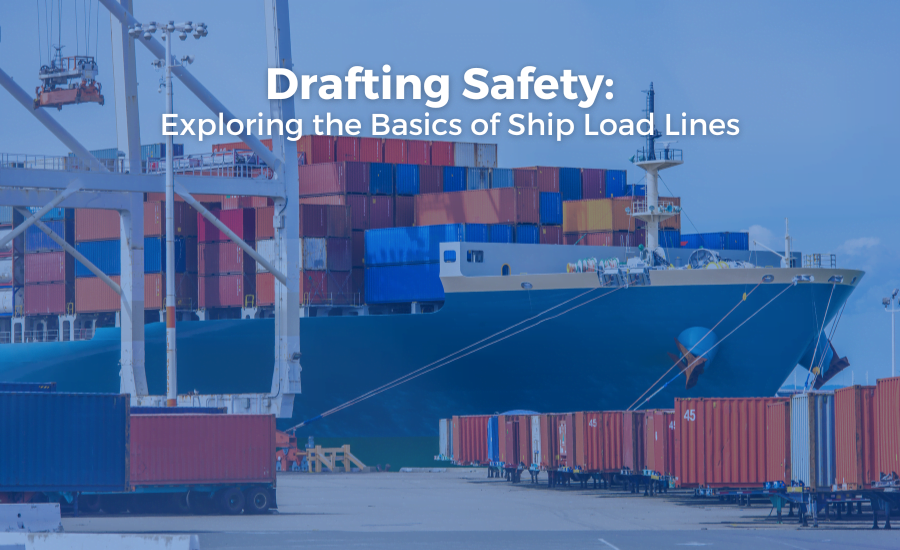
If I try to define a loading line most simply, it will look like this.
The ship load line is a special mark placed in the center of the ship that represents the draft of the ship and the maximum permissible limit in a certain type of water. If the load line is drawn on the power characteristic curve in the diagram, the work makes contact at a point called the point/stationary point or Q point.
The Importance of Uniform Upper Limits
Its importance for ships has been recognized for many years, as the overloading of ships has caused numerous maritime accidents at sea. However, reaching an international agreement on the universal use of overhead power lines took many years. Despite the challenges, the global maritime community eventually established the Basics of Ship Load Lines, which set the standards for ships’ safe loading and stability. As a result, ships are now comply with these regulations to ensure the safety of their operations. The first international freeboard competition was held in 1930. Furthermore, the website underwent a major redesign in 2010. Moreover, small adjustments have been made as needed to keep the content up to date.
Purpose and Need for Freeboard
The Basics of Ship Load Lines freeboard was born in England in the 1870s to prevent the overloading of merchant ships. The basic purpose of a stowage line is to establish the maximum legal limit on which a vessel loads cargo. By specifying such limits, it is possible to limit the risk of a vessel operating with insufficient freeboard or buoyancy. A ship must always have sufficient freeboard. However, any exceptions will result in insufficient stability and undue stress on the hull. The freeboard line plays an important role here, detecting if the ship is overloaded and ensuring that the freeboard remains very comfortable.
Lloyd’s Register has established minimum freeboard requirements for its classified vessels to ensure adequate buoyancy reserve in heavy seas. However, it is not practical to always set a standard freeboard limit for a ship, as the buoyancy and immersion of a ship are highly dependent on the type of water and its density. For this reason, the Freeboard Treaty sets out rules for dividing the world into different geographical zones and establishing a prescribed freeboard line for each zone. For example, a ship sailing in the North Atlantic in the winter will have more freeboard than one sailing in tropical or freshwater areas.
Understanding Load Line Markings and Types
Moreover, shipload lines are special markings present in the center of the ship. All vessels over 24 meters in length must have this loading line marking mid-length at the summer loading waterline.
Basics of Ship Load Lines
This applies to all vessel types.
Timber Loading Line Sign
This applies to vessels carrying timber cargoes. First, these marks must be engraved on the surface of the ship so that they are visible even when the side of the ship is faded in color. In addition, markings should still be painted white or yellow on a dark background, or black on a light background. A complete load line marking consists of three important parts. The deck line is a 300mm x 25mm horizontal line. It passes over the top of the freeboard. Ship Load Line Disc is a circular disc with a diameter of 300 mm and a thickness of 25 mm. A horizontal line intersects it. Additionally, the lower part of the horizon is referred to as the “Winter Saltwater Line” or the “Load Line.”
Load Line
The ship load line is a horizontal line extending forward and backward from a vertical line at a distance of 540mm from the center of the disc. It measures 230mm x 23mm. Also the top of the loading line indicates the maximum depth and the vessel is S.
S-Summer:
This is the main freeboard line at the same altitude as the Plimsoll line. Marked based on the gunwale.
T – Tropical:
This is 1/48 of the summer draft marked above the summer load line.
W – Winter:
This is 1/48 of the summer draft marked below the summer load line.
WNA – Winter North Atlantic:
Marked 50 mm below winter load line. Applies to winter travel in the North Atlantic (above the 36th parallel).
F – Freshwater:
This is the summer freshwater stress line The distance between S and F is the freshwater volume (FWA).
TF
Tropical Freshwater is a tropical freshwater loading line. An amount equal to FWA is marked above the T.
Draft Survey
Loading lines, in addition to being associated with buoyancy reserves and stability. Also to determine with reasonable accuracy the amount of cargo on board a ship through a draft survey. A draft survey is used to determine the weight of all materials to be loaded onto or unloaded from a ship. The displacement of the water before and after unloading is measured. However as a result, the difference between the two resulting displacements represents the weight of the load. Additionally, draft surveys are based on sound mathematics. However, typically a ship’s officer determines a ship’s draft by visual reference to draft marks on the ship’s bow, amidships, and stern. Furthermore, a list of listed ships must be estimated.
Furthermore, at many ports, a draft survey is the only way to independently verify the quantity of cargo a shipper declares to have shipped. Additionally, it is the only way to verify the accuracy of the quantities listed on the bill of lading. Usually, this information comes from the shipper, and the amount of cargo on board the ship before unloading begins.
According to Samuel Plimsoll, a member of the British Parliament. Additionally, in the 1870s, he also campaigned for a law requiring all ships to clearly display a line that disappears into the water in case of overload.










